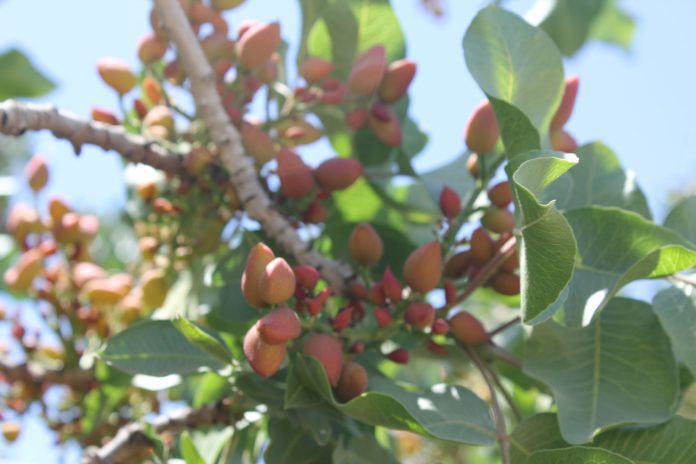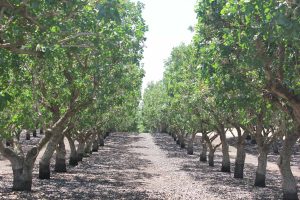
After California’s first billion-pound pistachio crop in 2020, the question was, should the industry have expected an ‘off’ year in 2021? IN fact, despite it technically being an off year, yields came close to the previous year’s record.
Bob Klein, executive director of the California Pistachio Research Board, said the records from 2020 show it wasn’t a real ‘on’ year despite the record billion pounds plus shaken from the state’s pistachio orchards. Klein said if you look at the pounds per acre, trees in 2020 produced an average of 2,800 pounds per acre. In an on year, Klein said, the expectation is higher at 3,000 pounds per acre. So, what has, and has not, changed when it comes to alternative bearing in pistachios?
What Has Not Changed
What has not changed is the physiology of alternate bearing. There is strong evidence it is an evolutionary survival strategy that evolved in wild fruit and nut trees before they began to be cultivated for yield. Alternate bearing is a within-bearing-shoot phenomenon. And it is more pronounced in an apically dominant deciduous species like pistachio which have a limited number of bearing points (shoots per tree) versus a spur bearing species like apple or almond with thousands of bearing spurs. While the specific physiological mechanism of alternate bearing is unknown, the visible mechanism is easily observable. As the pistachio kernel is growing within the fully expanded pistachio shells, the buds for the following year’s crop begin to abscise.
By mid-August, the next year’s potential crop of an individual shoot is easily observed. As the shoots on a tree are all part of the same tree in the same soil exposed to the same environment, it is not surprising the shoots within a tree, the trees within an orchard and orchards within a region synchronize. Earlier research by Kern County Farm Advisor Craig Kallsen, UCCE Specialist Louise Ferguson’s lab, and current research, specifically that of Dr. Maciej Zwieniecki’s “Carbohydrate Observatory”, strongly support the hypothesis that the current year’s yield is primarily a function of the previous years’ crop. Physiologically, the tree’s current-year resources, carbohydrates available to support the future crop, determine the crop for the following year by precipitating bud drop. Specifically how they precipitate bud drop is unknown. A good review of alternate bearing in pistachio is available at link.springer.com/article/10.1007%2Fs00468-020-01967-y. Finally, it is important to remember presenting bud drop will not decrease alternate bearing. In 1986, Ferguson (ACP Archives) demonstrated 2,4-D will prevent bud drop during and through the current season, but the buds do not produce the following season.
What Has Changed
What has changed, in this order, is production practices, the genetics of pistachio rootstocks and the industry composition of bearing to non-bearing trees. In 1995 Ferguson, Maranto and Beede demonstrated severe mechanical topping entering the low crop year strongly mitigated alternate bearing in ‘Kerman’ pistachios on an Atlantica rootstock.
What the trial demonstrated was that the mechanical pruning did not affect the mechanism of alternate bearing. What the topping did was produce a better composition of bearing to non-bearing shoots per tree, effectively “damping” the intensity of the alternate bearing. Beede followed this trial with another in a mature Kerman block with four seedling rootstocks: Atlantica, Integerrima, or Pioneer Gold I, and their two reciprocal seedling hybrids, rootstocks now marketed as seedling and cloned UCBI and the clone Platinum®.
This trial demonstrated two things: First, trees on Atlantica and PGI rootstocks, in that order, strongly alternate bear, and this alternate bearing is more strongly mitigated by mechanical topping entering the low-crop year; second, this trial demonstrated that it did not matter when the Kerman trees on both seedling hybrid rootstocks were mechanically pruned; before the low-crop or high-crop year, alternate bearing was fully one third to one half that of Kerman on either Atlantica or Integerrima rootstocks respectfully. These trials demonstrated that Integerrima parentage in a pistachio rootstock introduces vigor that interacts with mechanical pruning to decrease alternate bearing.
Because this trial did not include unpruned or hand-pruned controls (which, depending upon severity, could approximate severe topping), it cannot be determined from these results which had a stronger effect on alternate bearing, rootstock or pruning. However, the implication from these results is that the decreased alternate bearing we are increasingly seeing in pistachio production in recent decades is a result of a higher percentage of trees on hybrid rootstocks and a greater incorporation of moderate annual or biennial mechanical pruning.

Since 2015, 40,000 to 65,000 acres per year have been entering production, increasing production each year and effectively damping the overall industry alternate bearing of the mature trees.
Important Points
Two important points about alternate bearing and pruning: First, the interaction of rootstock and mechanical pruning did not change the mechanism of alternate bearing within a bearing shoot; buds on a bearing shoot still drop in response to the shoot’s crop load; second, pruning is not “thinning”. Thinning is decreasing the number of nuts within the rachis, reducing the demand the shoots resources. Thinning is commonly done in another alternate bearing fruit, olives, to reduce the number of fruit on a shoot, enabling the remaining fruits to become larger. Yield is not decreased, but the olives are larger and more valuable.
A third factor that has reduced industry-wide alternate bearing composition is bearing acreage. Within the last six years, since 2015, 40,000 to 65,000 acres per year have been entering production, increasing production each year and effectively damping the overall industry alternate bearing of the mature trees. The alternate bearing might look smaller now, said Klein, but the on/off cycle in an individual orchard has not changed much. And pistachio acres coming into production haven’t yet established an alternate bearing cycle.
Finally, as Kallsen notes, weather in an individual year can strongly affect alternate bearing. Though the preceding crop year may end with sufficient buds and carbohydrate resources for a potentially good crop, weather can decrease it. Poor winter chill in 2013-15 strongly decreased yields. Weather during bloom, too high or too low, can also decrease yields.
In conclusion, alternate bearing is an interesting physiological problem that affects pistachio production, but we have some tools to mitigate it, specifically rootstocks and canopy management. How it is affected by a changing climate is becoming more obvious. But, as Kallsen notes, it is not the problem it appeared to be in the early years of the industry.

Cecilia Parsons
Cecilia Parsons has spent the past 30 years covering agriculture in California for a variety of newspapers, magazines and organizations. During that time she has been fortunate to witness some of the important events that have shaped this diverse industry and worked hard to examine and explain these events for readers.
When Cecilia first moved to the San Joaquin Valley in 1976, her first journalism job was at a small daily newspaper where she covered “farm news.” From there she branched out to writing for a dairy magazine and a regional weekly agriculture publication.
Cecilia is part of a farming family from the rural community of Ducor where she also raises purebred sheep and is attempting to master versatility ranch horse riding.










